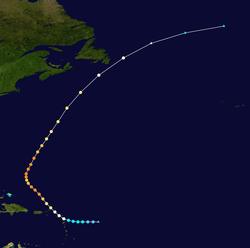Hurikán Gonzalo
| Hurikán Gonzalo | |||||||||||||||
|---|---|---|---|---|---|---|---|---|---|---|---|---|---|---|---|
 Gonzalo 16. října 2014, vrchol intenzity | |||||||||||||||
| Informace | |||||||||||||||
| Kategorie | |||||||||||||||
| Zformování | 12. října 2014 | ||||||||||||||
| Rozptýlení | 20. října 2014 | ||||||||||||||
| Nejnižší tlak | 940 mb/hPa | ||||||||||||||
| Nejvyšší rychlost | 1 min. průměr 230 km/h | ||||||||||||||
| Škody | 200–400 milionů US$ (k 2014)[1] | ||||||||||||||
| Oběti | 4 potvrzení | ||||||||||||||
| Postižené oblasti | Závětrné ostrovy, Portoriko, Bermudy, Atlantická Kanada, Evropa | ||||||||||||||
| Trasa bouře | |||||||||||||||
 | |||||||||||||||
| |||||||||||||||
| Součást | |||||||||||||||
| atlantické hurikánové sezóny 2014 | |||||||||||||||
| Některá data mohou pocházet z datové položky. | |||||||||||||||
Gonzalo je jméno silného atlantického hurikánu, který měl uprostřed října 2014 ničivé účinky v prostoru Malých Antil, Bermud a Velké Británie. Večer a v noci 21. října přišla jako dozvuk hurikánu do střední Evropy studená fronta, která přinesla sněhové přeháňky a místy vítr síly až orkánu.[2]
Odkazy
Reference
- ↑ Modellers estimate $200m-$400m in insured losses from Gonzalo. The Royal Gazette [online]. 2014-10-22 [cit. 2014-10-23]. Dostupné online. (anglicky)
- ↑ NEČÁSKOVÁ, Pavlína. Hurikán Gonzalo komplikuje dopravu v Británii, do Česka přivane studenou frontu. Rozhlas.cz [online]. 2014-10-21 [cit. 2014-10-23]. Dostupné online.
Související články
- Atlantická hurikánová sezóna 2014
Externí odkazy
 Obrázky, zvuky či videa k tématu hurikán Gonzalo na Wikimedia Commons
Obrázky, zvuky či videa k tématu hurikán Gonzalo na Wikimedia Commons
Média použitá na této stránce
The most intense hurricane of the 2014 Atlantic season was forecast to pass directly over Bermuda on October 17. The Bermuda Weather Service expected hurricane force winds to arrive in the afternoon, with the most destructive winds battering the island through the evening. Seas in nearby Atlantic waters were building to 35 to 40 feet. Meteorologists were predicting 3 to 6 inches of rainfall and potentially life-threatening storm surges.
The Moderate Resolution Imaging Spectroradiometer (MODIS) on NASA’s Aqua satellite acquired this natural-color image of Hurricane Gonzalo at 12:45 p.m. Atlantic Daylight Time (1745 Universal Time) on October 16, 2014. At the time, the category 4 hurricane had sustained winds of 125 knots (145 miles or 230 kilometers per hour) and a central pressure of 942 millibars. (Click here for a view of the storm on October 17, 2014.)
Bermuda, which took a partial hit on October 12 from Tropical Storm Fay, has only seen 10 hurricane centers pass within 120 kilometers (75 miles) since 1899, according to The Weather Channel. The last major hurricane to strike Bermuda was Fabian in September 2003. That storm brought 190 kilometer (120 mile) per hour winds and a 3-meter (10-foot) storm surge.
Long-range forecasts for Gonzalo show the storm staying at hurricane force as far north as 50° latitude and brushing the edges of Nova Scotia. Meteorologists in Great Britain anticipated heavy rainfall and winds by October 20, when remnants of Gonzalo were expected to reach that island.Track map of Hurricane Gonzalo of the 2014 Atlantic hurricane season. The points show the location of the storm at 6-hour intervals. The colour represents the storm's maximum sustained wind speeds as classified in the (see below), and the shape of the data points represent the nature of the storm, according to the legend below.
Storm type


